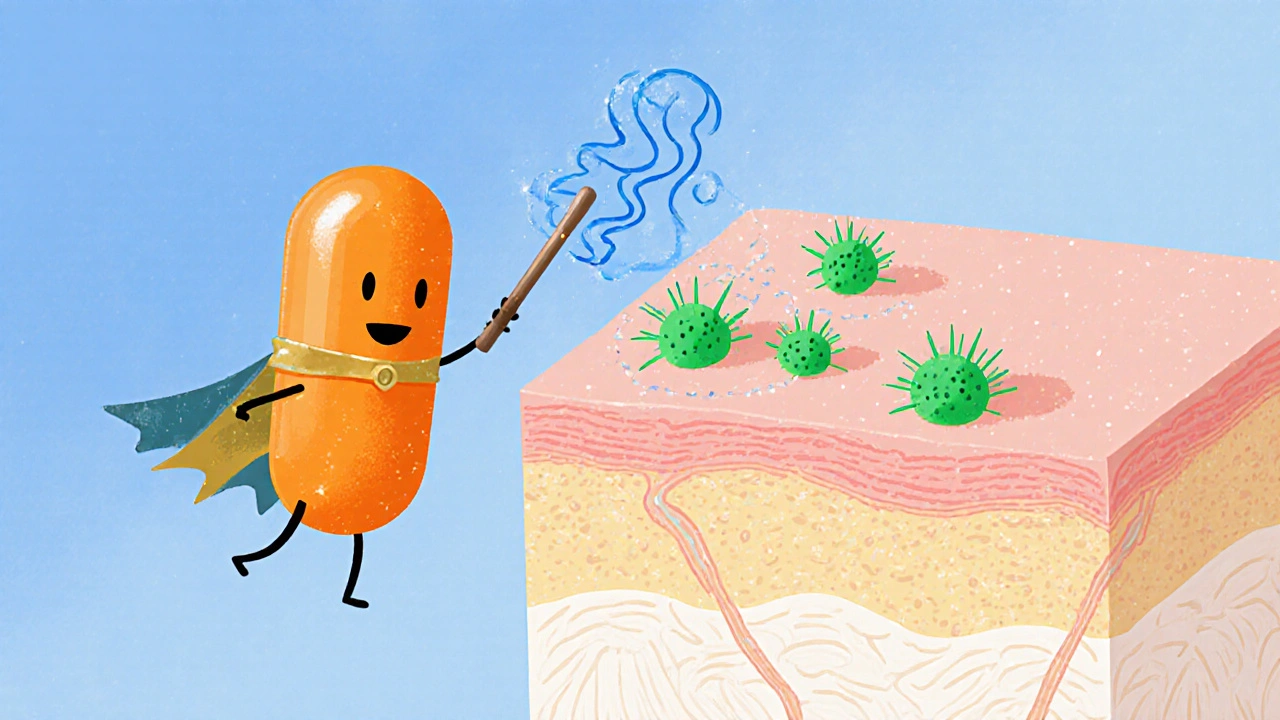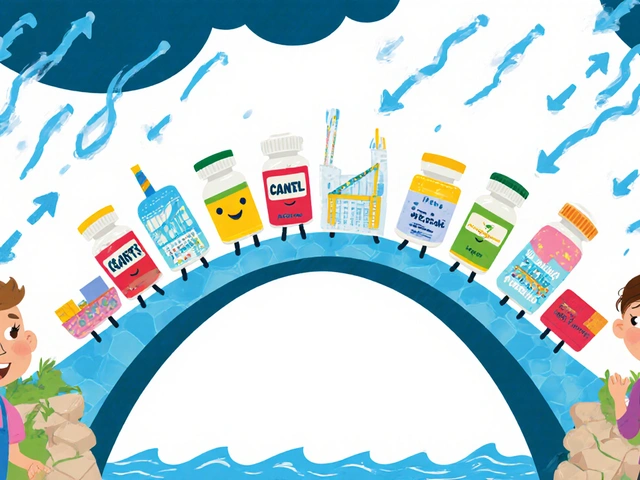Griseofulvin Dosage Calculator
Calculate Your Griseofulvin Dosage
This tool calculates appropriate griseofulvin dosage based on patient characteristics. Always consult your doctor before taking medication.
Imagine waking up to a ring‑shaped, itchy rash on your arm that just won’t fade. That’s Griseofulvin an oral antifungal medication that has been used for decades to treat skin infections caused by dermatophytes. If you’ve Googled "tinea corporis treatment" you’ve probably seen that name pop up, but why would a doctor pick it over newer drugs? This article walks you through the science, the practical details, and the pros and cons so you can decide if it’s the right option for your case.
Key Takeaways
- Griseofulvin is effective against many dermatophytes, especially Trichophyton rubrum and Microsporum species.
- Typical adult dosing is 500‑1000mg daily for 4‑8weeks, but longer courses may be needed for extensive infections.
- Common side effects include headache, GI upset, and photosensitivity; liver‑function monitoring is recommended.
- Newer oral agents like terbinafine and itraconazole often work faster and have fewer drug‑interaction concerns.
- Pregnant or nursing patients should avoid griseofulvin unless a physician deems benefits outweigh risks.
What is Tinea Corporis?
Tinea Corporis is a superficial fungal infection of the body’s skin, commonly called "ringworm" because of its circular lesions. It’s caused by dermatophytes-fungi that love keratin, the protein in skin, hair, and nails. The most frequent culprits are Trichophyton rubrum, Trichophyton mentagrophytes, and various Microsporum species. The rash usually appears as a red, scaly border with a clearer center, and it can spread through direct skin‑to‑skin contact or contaminated surfaces.
How Griseofulvin Works
Griseofulvin belongs to the class of antimycotic agents that interfere with fungal cell division. Once absorbed, it accumulates in keratinous tissue. When dermatophyte spores try to grow, the drug disrupts microtubule formation, preventing mitosis. Because it stays in the skin for weeks after the last dose, it provides a “post‑treatment” shield that helps prevent relapse.
When Doctors Choose Griseofulvin
Even with newer drugs on the market, clinicians still reach for griseofulvin in specific scenarios:
- Extensive or chronic infections that require a drug with a long tissue half‑life.
- Patients with Trichophyton infections that are known to respond well to griseofulvin.
- Cases where cost is a major factor-generic griseofulvin is usually cheaper than brand‑name terbinafine.
- When there’s a need to avoid drug‑interaction issues common with azole antifungals (which inhibit CYP450 enzymes).

Dosage Guidelines
Griseofulvin dosing varies by age, weight, and infection severity. Below is a quick reference:
- Adults: 500‑1000mg taken orally once daily (or divided into two doses if GI upset occurs).
- Children (≥10kg): 20‑25mg/kg per day, usually given in two divided doses.
- Treatment length: 4weeks for limited lesions; 6‑8weeks for widespread or scalp involvement.
- Take the medication with a fatty meal-food boosts absorption by up to 40%.
Because the drug is metabolized by the liver, physicians often order baseline liver‑function tests and repeat them after 2‑4weeks, especially for patients on high doses or with pre‑existing liver disease.
Side Effects and Safety Considerations
Most people tolerate griseofulvin well, but you should be aware of the common and rare adverse events:
- Headache - the most frequently reported complaint.
- Gastrointestinal upset (nausea, abdominal cramps).
- Photosensitivity - the skin can burn more easily in sunlight; sunscreen and protective clothing are a must.
- Hepatotoxicity - elevated liver enzymes; rare but serious.
- Blood‑cell changes - occasional leukopenia or thrombocytopenia.
In pregnancy, griseofulvin is classified as Category X (contraindicated) due to animal‑study evidence of fetal harm. Breast‑feeding mothers should also avoid it because the drug can pass into milk.
How Griseofulvin Stacks Up Against Other Oral Antifungals
| Drug | Mechanism | Typical Adult Dose | Treatment Duration | Key Side Effects |
|---|---|---|---|---|
| Griseofulvin | Disrupts fungal microtubules | 500‑1000mg daily | 4‑8weeks | Headache, GI upset, photosensitivity, liver enzymes |
| Terbinafine | Inhibits squalene epoxidase | 250mg daily | 2‑4weeks | Rash, taste disturbance, rare liver issues |
| Itraconazole | Inhibits CYP450‑dependent fungal sterol synthesis | 200mg twice daily | 2‑6weeks | GI upset, heart failure risk, drug interactions |
| Ketoconazole (oral) | Blocks ergosterol synthesis | 200mg twice daily | 2‑4weeks | Severe hepatotoxicity, adrenal suppression |
Notice the shorter courses with terbinafine and itraconazole-those agents often clear lesions faster. However, they are metabolized by CYP450 enzymes and can clash with cholesterol meds, antidepressants, or antiretrovirals. Griseofulvin’s slower action is offset by its low interaction potential.

Practical Tips for Patients on Griseofulvin
- Take the pill with a meal that includes dairy or oil; this boosts absorption.
- Avoid prolonged sun exposure; wear sunscreen SPF30+ and long sleeves.
- Stay hydrated and keep the skin clean; dry lesions heal faster.
- Schedule liver‑function tests as your doctor advises-usually at baseline and midway through therapy.
- If you miss a dose, take it as soon as you remember unless it’s almost time for the next dose. Don’t double‑dose.
When Griseofulvin Might Not Be the Best Choice
Consider alternative agents if you fall into any of these groups:
- Pregnant, trying to conceive, or breastfeeding.
- History of liver disease or abnormal liver enzymes.
- Concurrent use of many CYP450‑metabolized drugs (e.g., certain antiepileptics, warfarin).
- Need for a rapid cure-terbinafine can clear most infections in two weeks.
Discuss these factors with your clinician; they can tailor the regimen or switch you to a more suitable medication.
Frequently Asked Questions
How long does it take for griseofulvin to clear a ringworm infection?
Most patients see improvement within 2‑3weeks, but full clearance usually requires 4‑8weeks of continuous therapy.
Can I take griseofulvin with other medications?
Griseofulvin has fewer drug‑interaction issues than azoles, but it can still affect warfarin and oral contraceptives. Always list every prescription and over‑the‑counter product for your doctor.
Is it safe to use griseofulvin while pregnant?
No. Griseofulvin is classified as pregnancy Category X because animal studies showed fetal toxicity. Alternative topical agents are preferred during pregnancy.
Do I need to monitor my liver while on the drug?
Yes. Baseline liver‑function tests (ALT, AST, bilirubin) are standard, with repeat testing after 2‑4weeks, especially for high‑dose or long‑duration courses.
Can I use sunscreen while taking griseofulvin?
Absolutely. In fact, because the drug increases photosensitivity, daily sunscreen with at least SPF30 is strongly recommended.
Griseofulvin remains a solid, affordable option for many people battling tinea corporis, especially when cost, drug interactions, or extensive infection are concerns. By understanding how it works, the right dose, and what to watch for, you can make an informed decision alongside your healthcare provider.






14 Comments
Picture this: you’re scrolling through a list of antifungals, and suddenly Griseofulvin pops up like a relic from the 80s, demanding your attention with its old‑school charm.
It’s not just a pill, it’s a saga of microtubule sabotage that lingers in your skin like an unwelcome guest at a family reunion.
Doctors still reach for it when the budget whispers “cut costs” and the infection looks like it’s planning a long‑term occupation.
Because it embeds itself in keratin, the drug keeps on working even after you’ve finished the bottle, which feels like a protective cloak that never truly lifts.
The dosage, a hefty 500‑1000 mg a day, can feel like you’re swallowing a brick, yet many swear by the steady, measured progress they see week after week.
Side effects, like a stubborn headache and that annoying photosensitivity, turn sunny days into a gamble, forcing you to become a sunscreen aficionado overnight.
Liver‑function tests become your new routine check‑ups, a reminder that the liver is the unsung hero silently detoxifying the chemical assault.
If you’re pregnant, the drug is a no‑go, because the animal studies showed enough trouble to write it straight into the X category, making alternatives a safer bet.
Cost is another drama: a generic bottle can be cheaper than a brand‑name terbinafine series, so insurance companies love it the way a low‑budget movie loves a cult following.
On the flip side, newer drugs like terbinafine and itraconazole sprint through the infection in half the time, leaving Griseofulvin looking like a marathon runner who forgot his shoes.
But when drug‑interaction landmines are littered around your prescription list, Griseofulvin’s clean‑interaction profile becomes a hero in disguise.
Patients with extensive or chronic infections often need that long‑term tissue reservoir, which only Griseofulvin can provide without causing a cascade of CYP450 chaos.
The pill’s absorption loves a fatty meal, so you might as well pair it with a cheeseburger to give it a boost, a tip that feels both clinical and oddly culinary.
All in all, the drug is a paradox: outdated yet indispensable, expensive yet cost‑effective, slow yet persistently protective.
So before you dismiss it, consider the whole picture, because sometimes the old guard holds the key to a steady, reliable cure.
Honestly, I think most people overlook how affordable Griseofulvin is when they chase the newest “quick‑fix” meds 😊. It may take longer, but the low interaction risk is a huge plus for anyone on multiple prescriptions. Still, if you can tolerate a short course, newer agents do clear lesions faster.
What they don’t tell you is that the pharma giants push the newer drugs to keep the profit pipelines flowing, while the old‑school meds like Griseofulvin stay cheap because they’re out of patent and the big companies can’t milk them anymore. It’s almost like the whole system is designed to keep you guessing which treatment is “best,” but the truth is buried under marketing budgets and hidden research.
i dnt think its worth the hassle tbh.
cheap but slow
Hey, if you’re starting Griseofulvin, keep a consistent schedule and track any side effects in a diary. Pair the dose with a fatty snack to boost absorption, and don’t forget daily sunscreen – it’ll save you a lot of discomfort later. Regular liver check‑ups are a smart move, especially if you’re on a higher dose. You’ve got this!
In the grand theatre of medicine, every pill is a character playing its part, and Griseofulvin embodies the steadfast elder who refuses to rush the climax, teaching us patience in the face of restless skin rebels.
Dear reader, it is with great enthusiasm that I commend your dedication to understanding the nuances of antifungal therapy; may your commitment to informed health decisions continue to flourish with unwavering resolve.
Sometimes I wonder if the “photosensitivity” warning is really about the drug or a hidden signal to keep us under surveillance when we step outside.
This cheap drug is a proper British bargain, nobody needs to overcomplicate treatment with fancy names.
OMG!!! Griseofulvin is like that ancient relic you find in your grandma’s attic-so old, so dusty, and yet somehow it still works like a charm!!! I mean, seriously, who even cares about those shiny new pills when you can just pop a cheap tablet and wait for weeks while the fungus cowers!!! The side effects? Yeah, maybe a headache, maybe a bit of sunburn, but THAT’S A SMALL PRICE TO PAY FOR A CURE!!! And don’t even get me started on the cost-cheaper than a latte a day!!! The pharma lords want you to chase the latest hype, but we’re smarter than that, right??? Let’s be real, the drug’s clinginess to keratin is like a clingy ex that just won’t let go-it’s actually good in this case!!! So grab a fatty meal, slather on sunscreen, and watch the infection fade like a bad memory!!!
I have to say, the whole hype around Griseofulvin feels like an overblown drama that feeds on our fear of fungus while selling us patience as a virtue. It’s like being told to wait for a train that runs on an unpredictable schedule, and you end up standing on the platform, sweating, watching the minutes tick by. The side‑effects, the liver checks, the endless reminders to avoid sunlight-it’s a cascade of inconveniences that drain motivation. Yet, there’s a strange comfort in its reliability, a sort of nostalgic trust that we’re not just another test subject for a shiny new molecule. I can’t help but feel a pang of exhaustion each time I think about committing to eight weeks of daily pills, especially when life already hands you enough chores. Still, if you’re on a shoestring budget or juggling a cocktail of other meds, that cheap, low‑interaction profile might just be the lifeline you need. In the end, the drug is both a burden and a blessing, a paradox that mirrors the messy reality of chronic skin conditions.
It’s interesting how a simple antifungal can become a reminder that healing often requires both time and patience 🌱. Embracing the slow process can teach us resilience, and knowing we’re not alone in this journey brings comfort.
Thanks everyone for the insights! It really helps to see the pros and cons laid out from different angles-makes the decision feel less daunting!